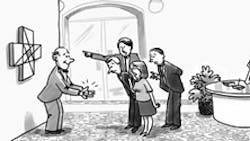Side issue
Problem 183 — The hole can be bigger than the sum of the parts, as this month’s problem by Tim Tebbe of Tarboro, N.C., demonstrates.
In the newly redesigned lobby of the ZCross Engineering Co. a consultation was getting more heated by the minute. The new logo was all set to be installed, when company president Zeke Ross had a better idea. He turned to face his entourage.
“Why, we’ll use these four little square silver tiles in the center diamond-shaped area instead. I’ve had them flown in from Europe especially, and the man assured me they would cover the center of the logo. They each measure 0.125 ft on a side! The effect will be magnificent!”
“It’ll clash with the upholstery,” commented his first private secretary.
“The green tiles are already in place,” remarked the second private secretary.
“B-b-but there aren’t enough!” cried the third.
“A logo needs to stand out ...” began Ross.
“It shouldn’t glare,” interrupted #1, sensing the beginning of a lecture.
“The green tiles are already in place,” repeated #2.
“The silver tiles won’t cover it,” bemoaned #3.
“Nonsense!” thundered Ross. “See to it!”
The logo is as pictured. The center area in question is the small, diamond shape in the middle square. If each of the four squares has sides of 1 ft., what is the area of the small square?
Send your answer to: Fun With Fundamentals POWER TRANSMISSION DESIGN 1100 Superior Ave. Cleveland, OH 44114-2543
Deadline is June 10. Good luck! Technical consultant, Jack Couillard, Menasha, Wis.
Solution to last month’s problem 182 — You know when not to give up, if you answered yes. (The helicopter will be able to climb the cliff.) Here’s the small torque:
First compute the tail rotor torque necessary to counteract main-rotor torque. To do this, we need to find: 1. Main rotor torque, 2. How long the chopper takes to climb the cliff, 3. The mainrotor rpm, and 4. The percentage of rpm left at the end of that time.
Let:
t = Time to climb cliff, min.
r = Rotor tip speed, given as 700 fps for both rotors
p = Engine power, given as 1,200 hp
dm = Diameter of main rotor, given as 40 ft
s = Moment arm of tail rotor, given as 24.5 ft
First, calculate t. We know that the helicopter has to climb 700 ft (720 - 20 ft), and that the helicopter’s rate of climb is 500 fps. t is then 700 ft ÷ 500 fpm, or 1.4 min.
During that time, rotor rpm drops 8% per min from its original 90%. At the end of the climb, it is at 78.8% Using this data and the basic equation v 5rv, the final rotor rpm is
Now calculate maximum available tail rotor thrust.
